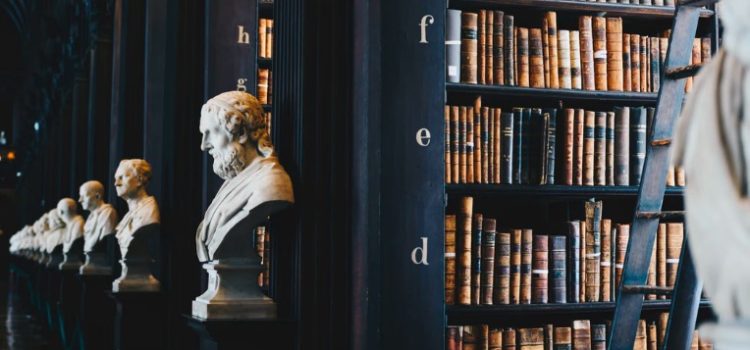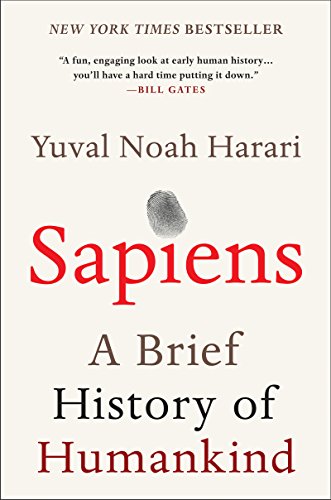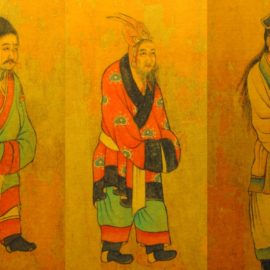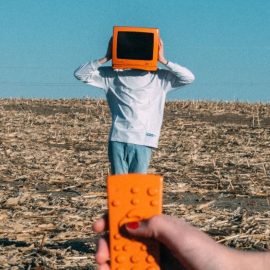

This article is an excerpt from the Shortform summary of "Sapiens: A Brief History of Humankind" by Yuval Noah Harari. Shortform has the world's best summaries of books you should be reading.
Like this article? Sign up for a free trial here .
What are the basic events in the history of humankind? What revolutions characterized the cognitive and cultural evolution of homo sapiens?
The history of humankind is punctuated by four major revolutions: The Cognitive Revolution, the Agricultural Revolution, the Industrial Revolution, and the Scientific Revolution. These revolutions changed the history of humankind in ways both positive and negative.
We’ll look at each revolution and how it dramatically redirected the course of human history, but to understand these upheavals, we need to go back to a time when Homo sapiens was just one of multiple human species (and not a very distinguished species, at that).
The History of Humankind
Multiple Human Species
The first thing to know about the history of humankind is that we weren’t the only humans. We think of our own species as the only humans, distinguished from and superior to every other species on earth. But when we, Homo sapiens, arrived on the scene 2.5 million years ago, we weren’t anything special. We existed in the middle of the food chain, as often prey as we were predators, and we weren’t even the only humans.
The Eight Human (Homo) Species
Humans evolved in East Africa from a genus of apes. These early humans settled all over the world, and as the climates and conditions differed from place to place, they acquired different traits and became different species.
We tend to think of the evolution of humans as a linear progression from Homo erectus to Neanderthals to Homo sapiens, but at least six human species were alive when our own lived on earth, and others may yet be discovered. The known human species included Homo soloensis, Homo floresiensis, Homo denisova, Homo rudolfensis, and Homo ergaster. The three that will play the biggest roles in the history of humankind are:
1. Homo neanderthalensis (“Man from the Neander Valley”): Also known as Neanderthals, these humans lived in western Asia and Europe. They were more muscular than we were and they had bigger brains than we did (or do today). We’ll see why the Neanderthal species died out, even though Neanderthals were superior to Sapiens in many ways.
2. Home erectus (“Upright Man”): These humans lived in eastern Asia for almost 2 million years, making them likely to be the longest-living human species ever. (As we’ll see, it’s unlikely that Homo sapiens will be around 2,000 years from now, let alone 2 million.)
3. Homo sapiens (“Wise Man”): Us. Our species of man also evolved in East Africa.
History of Humankind: Shared Characteristics of Humans
Of the eight known human species, only one survived. Before we discuss how Sapiens became the dominant humans, let’s look at what all the human species had in common. This is an important feature in the history of humankind.
Characteristic #1: Large Brains
Mammals that are 130 lbs typically have a brain that’s an average of 12 cubic inches. In contrast, the brains of early humans were 36 cubic inches. Today, our average brain size is 73-85 cubic inches, and the brains of Neanderthals were even bigger than ours.
It seems like large brains would give us and our fellow humans an obvious advantage over other animals, but it wasn’t necessarily an asset to early humans.
The Disadvantages of a Big Brain
Big brains take a lot of energy to fuel. Our brains make up 2-3% of our body weight, but use 25% of our energy. (The brains of our ape siblings only use 8% of their energy.)
This drain of energy caused two main problems:
- Problem #1: Humans had to spend a lot of time searching for food (they needed a lot of calories to feed their hungry brains).
- Problem #2: Their muscles atrophied because their bodies had to divert energy from muscles to feed the brain.
When you’re in the middle of the food chain, trying to catch small animals and keep out of the way of big ones, using your energy to power your brain instead of your muscles isn’t the smartest strategy.
Characteristic #2: Walking Upright
Like having a big brain, walking upright seems like an unequivocally positive trait to us today, in part because we still walk upright and can’t imagine moving any other way. There were both advantages and disadvantages to walking upright.
Pros:
- A better view: When you’re standing, it’s easier to see the lion hiding in the grass or the prey oblivious to you.
- The ability to use tools: When you don’t need your arms for moving around, they’re freed up for other tasks, like signaling to others and using tools. As we evolved more nerve endings and agile muscles in our hands, our tools became more sophisticated.
Cons:
- An unstable skeleton: Because we’re built to walk on all fours like most mammals, our skeletal structure doesn’t easily support our large heads. Consequently, we get back and neck aches.
- Narrow hips: To walk upright, women (and men) evolved narrower hips, but this was bad news for childbirth. As women’s hips were getting narrower, babies’ heads were getting bigger.
Narrow hips especially had far-reaching consequences for humans, creating a domino effect that led to helpless babies. This was because the women who survived the dangerous activity of childbirth (and continued to pass on their genes through subsequent births) were the ones who gave birth early in the fetus’s gestation, when the baby’s head was smaller and undeveloped.
Consequently, women evolved to give birth earlier when the fetus is less developed. This means that human infants are undeveloped and helpless compared with other animal infants. For instance, a colt can start to run soon after birth, and a kitten finds food on its own after a few weeks. But human children are dependent on their parents for years.
The fact that human children were vulnerable for years after birth meant that human adults had to care for and protect them for years. Like having a big brain, this wasn’t an obvious advantage for early humans. They needed their energy for activities like escaping the jaws of larger, stronger animals.
The Consequences of Having Premature Babies
Despite the risks involved in caring for vulnerable infants, their existence created unique social situations for humans. These situations and the resulting societal bonds may have contributed to the rise of human dominance in the animal kingdom.
There were two unique results of human children being born prematurely:
Result #1: The “It Takes a Village” Mentality: Because children were so helpless, mothers relied on family members and neighbors to raise them. Many other animal genera (plural of “genus”) didn’t have the need to form these social bonds.
Result #2: The Potential for Socialization: Children born relatively helpless are (relative) blank slates. As such, their societies can shape them through education and socialization to be whatever they want them to be. Whereas other mammals are born like glazed earthenware coming out of the kiln (if you try to reshape them, they’ll break), humans are born like molten glass, easily formed and reformed.
History of Humankind: Last Man Standing
We shared much in common with our fellow humans. How did we rise from the middle of the food chain to the top? And how did we become the last humans standing?
Fire
The domestication of fire changed the game, giving humans power over the natural world that no other animal possessed. Fire was a source of light. It was warmth in the cold months and a weapon in moments of conflict. You could even use fire to burn through impassable underbrush, changing the landscape to fit your needs.
The most important use of fire was cooking. Cooking food made it easier to digest. Since digestion was easier, the long intestine became shorter. This development was especially important. Big brains and big intestines both use a lot of energy. By allowing humans to better digest food and evolve shortened intestines, fire may have indirectly contributed to the brain getting a greater share of the body’s energy. As the brain got more energy, it got bigger.
When humans mastered fire, they finally gained a key to developing dominance over animals that were stronger and faster than they were.
The Cognitive Revolution
The first major event in the history of humankind was the Cognitive Revolution. 2.5 million years ago, Homo sapiens was just one of eight human species. The first major revolution for Sapiens was the Cognitive Revolution 70,000 years ago. Before that point, Sapiens weren’t particularly special and weren’t superior to the other seven human species. The Cognitive Revolution involved the development of three new abilities, all related to language, that helped Homo sapiens outpace their fellow humans.
One reason the language of Sapiens was different was that it was more complex. Rather than communicating simple ideas the way green monkeys do (“Careful! A lion!” or “Careful! An eagle!”), the language of Sapiens could warn someone about a lion, describe its location, and plan how to deal with it. This allowed them to plan and follow through on complex actions like avoiding predators and working together to trap prey.
A second distinction of the Sapiens language was its ability to convey gossip. We think of gossip as a bad thing, but using language to convey information about other people is a way to build trust. Trust is critical for social cooperation, and cooperation gives you an advantage in the struggle to survive and pass on your genes. Sapiens could form groups of up to 150 people. They didn’t need to know every group member personally to trust them. In a battle, a small group of Neanderthals was no match for a group of 150 Sapiens.
A third benefit of the Sapiens’ language in the history of humankind was how it was used to create fictions, also known as “social constructs” or “imagined realities.”
Being able to communicate information about things that don’t exist doesn’t seem like an advantage. But Sapiens seem to be the only animals who have this ability to discuss things that don’t have a physical presence in the world, like money, human rights, corporations, and God.
Collective Fictions
In and of itself, imagining things that don’t exist isn’t an asset. What’s important about the ability to create fictions is the ability to create collective fictions, fictions everyone believes. These collective myths allow people who’ve never met and otherwise would have nothing in common to cooperate under shared assumptions and goals.
Collective fictions allowed early Sapiens to cooperate within extremely large groups of people, most of whom they’d never met, and it rapidly changed their social behavior.
The Agricultural Revolution
After the Cognitive Revolution came the Agricultural Revolution in the history of humankind. About 10,000 years ago, between 9500 and 8500 BC, Sapiens started shifting from forager lifestyles to a life revolving around agriculture. This was the Agricultural Revolution. It was so successful for our species that we went from 5-8 million foragers in 10,000 BC to 250 million farmers by the first century AD.
People started storing grain for later and invented stone scythes, pestles, and mortars. Because they saw that wheat grew better when it was buried deep in the soil rather than sprinkled on top, humans began to hoe and plow the fields. Weeding, watering, and fertilizing followed. With all this time spent on tending the wheat, there was less time to hunt and gather. Sapiens had become farmers.
Most of the surplus went to the elite, and they probably did live better lives than their ancestors. But the Agricultural Revolution didn’t immediately translate to a better life for most individuals.
The Scientific Revolution
The Scientific Revolution was a major turning point in the history of humankind. In the last 500 years, we’ve seen unprecedented scientific and technological growth, so much so that a time traveler from 1500 would recognize very little of our world. For instance, since 1500, the world population has grown from 500 million Sapiens to 7 billion. Every word and number in every book in every medieval library could be easily stored on a modern computer. Further, we’ve built skyscrapers, circumnavigated the earth, and landed on the moon. We’ve discovered the existence of bacteria and can now cure most diseases caused by it, even engineer bacteria for use in medicines. All of these advances were made possible by the Scientific Revolution.
In many ways, the Scientific Revolution was the result of a shift in the way Sapiens viewed the world and its future.
We post-Scientific Revolution Sapiens understand the world differently than our ancestors:
1. We are willing to acknowledge our ignorance: Today, we assume there are gaps in our knowledge, and we even question what we think we know. This wasn’t the norm before the Scientific Revolution.
2. We emphasize observation and mathematics: Rather than getting our knowledge from divine books, we use our senses and the technologies available to us to make observations. We then use mathematics to connect these observations and make them into a coherent theory.
3. We strive for new powers: Knowledge is only valuable in its use to us. We don’t develop theories for the sake of knowing more. We use theories to gain new powers — in particular, new technologies.
4. We believe in progress, whereas our ancestors believed that the golden age was behind them.
The Industrial Revolution
Next in the history of humankind was the Industrial Revolution. Economic growth requires more than just trust in the future and the willingness of employers to reinvest their capital. It needs resources, the energy and raw materials that go into production. While the economy can grow, our resources remain finite.
At least, that’s what we’ve thought for centuries. But the energy and raw materials that are accessible to us today have increased as a result of the Industrial Revolution. We now have both better ways of exploiting our resources and resources that didn’t exist in the worlds of our ancestors.
Breakthroughs in Converting Energy
The discovery of gunpowder introduced the idea that you could convert heat energy to movement, but this was such an odd concept that it took 600 years for gunpowder to be used widely in artillery. This was a groundbreaking concept in the history of humankind.
Another 300 years passed before the invention of the steam engine, which used also converted heat to movement, through the pressure of steam. After this, the idea of turning one type of energy into another didn’t seem so foreign. People became obsessed with discovering new ways to harness energy. For example, when physicists realized that the atom stores a lot of energy, they quickly devised ways to release it to make electricity (and bombs). The internal combustion engine turned petroleum, previously used to waterproof roofs and lubricate axles, into a liquid that nations fought wars over. Electricity went from being a cheap magic trick to something we use everyday and can’t imagine living without.
This prompted the new ethic of consumerism. Frugality became a bad word, and people were taught by industries that consuming was a positive thing. Self-indulgence is “self-care” and frugality is “self-oppression.”
Consumerism has changed our values, habits, and health.
- We think it’s normal that manufacturers make poor-quality, short-term goods and then invent new models that we don’t need but are told we do.
- Shopping is a huge part of holidays like Christmas and Memorial Day.
- In many countries, the poorest, who live on low-nutrition junk foods, are more likely to die of obesity rather than starvation.
- We spend huge amounts of money on food, and then we spend huge amounts of money on diet products, doubly supporting the growing economy.
Consumerism seems to conflict with the capitalist mentality of wasting nothing and reinvesting profits. While the two codes of ethics do conflict, they can inhabit the same space as the “capitalist-consumer ethic,” because this combined ethic has different rules for different people. The capitalist-consumer ethic tells the rich to invest and the poor to buy. The rich believe in frugality and investing, and the poor believe in buying and indulging. The rich manage their investments while the poor buy televisions and new phones they don’t need. The spending of the poor supports the wealth accumulation of the rich. The capitalist-consumer ethic allows the rich to keep getting richer and the poor to keep getting poorer.
Whether positive or negative, consumerism is an integral part of the history of humankind.
———End of Preview———

Like what you just read? Read the rest of the world's best summary of "Sapiens" at Shortform . Learn the book's critical concepts in 20 minutes or less .
Here's what you'll find in our full Sapiens summary :
- How Sapiens outlived and outlasted the 8+ other human-like species on Earth
- The 3 critical revolutions in human existence that led to our domination of the planet
- How much of what powers our world today is really just a shared mass delusion
- What the future of humanity might look like






